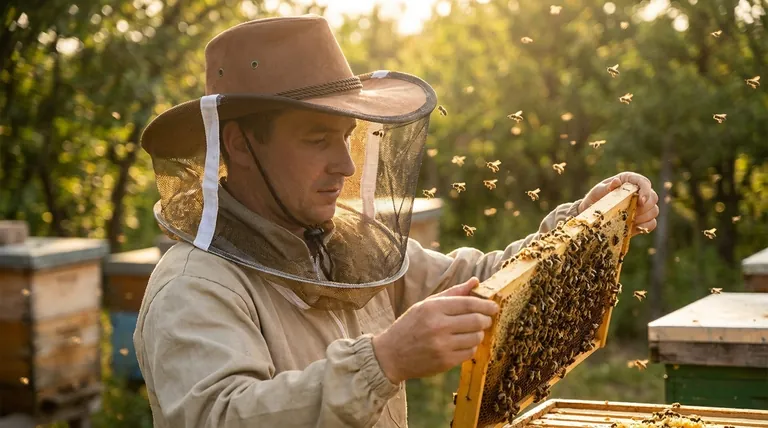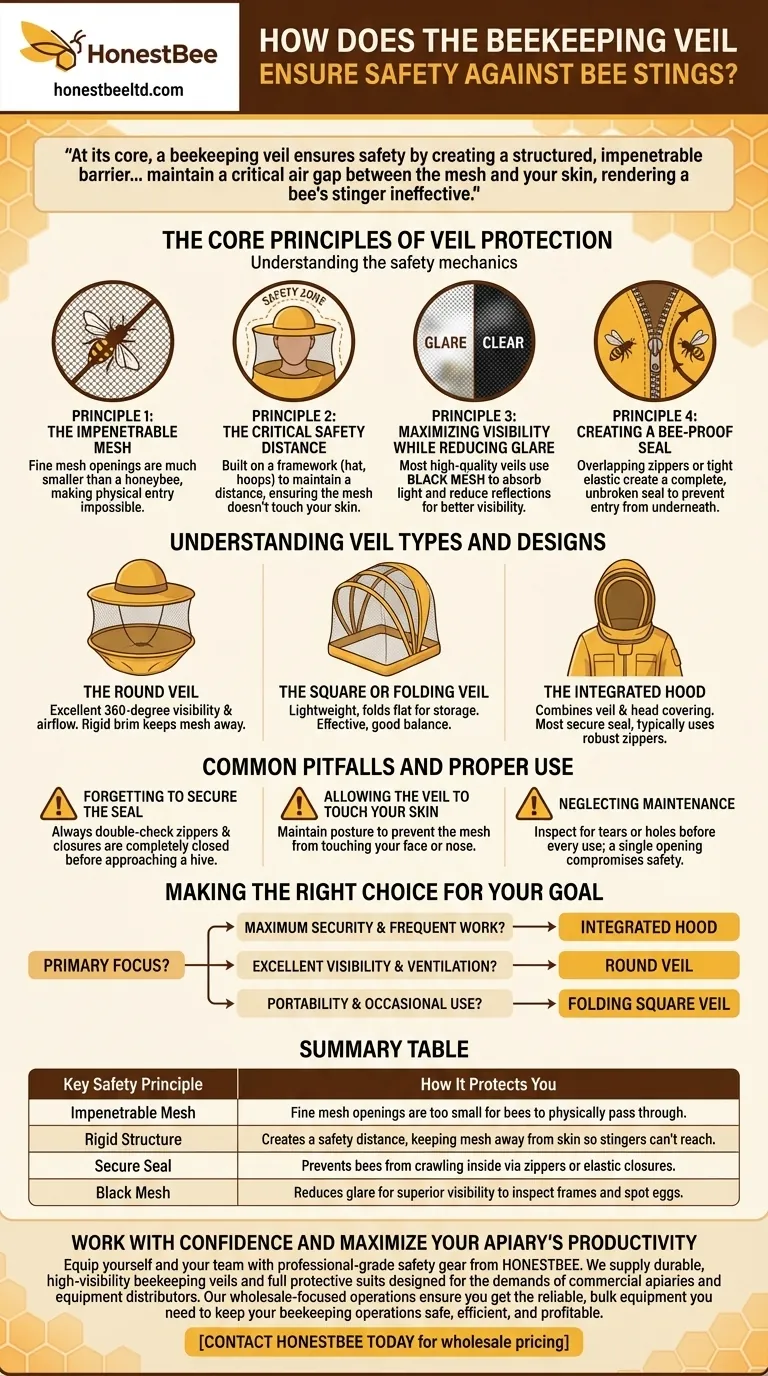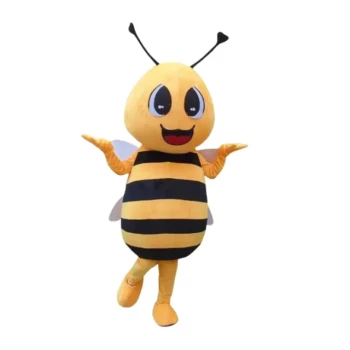At its core, a beekeeping veil ensures safety by creating a structured, impenetrable barrier around your head. It is specifically designed not only to block bees from reaching your face but also to maintain a critical air gap between the mesh and your skin, rendering a bee's stinger ineffective.
The primary function of a beekeeping veil isn't just to cover your face—it's to create a protected, visible workspace. Its effectiveness hinges on three key elements: a fine mesh, a rigid structure that keeps the mesh away from your skin, and a secure seal with your suit.

The Core Principles of Veil Protection
To trust your equipment, you must understand how it works. A veil's safety is not based on a single feature, but on the combination of several design principles working in concert.
Principle 1: The Impenetrable Mesh
The most fundamental feature of the veil is its mesh screen. The openings in the mesh are carefully sized to be much smaller than a honeybee, making physical entry impossible.
This creates the first and most obvious line of defense. It acts as a physical wall that bees cannot breach.
Principle 2: The Critical Safety Distance
A veil without structure is useless. If the mesh rests against your nose or cheek, a determined bee can sting directly through the opening.
This is why veils are built around a hat, helmet, or semi-rigid hoops. This framework forces the mesh to stand away from your face on all sides, creating a crucial "safety zone." A bee's stinger is too short to bridge this gap, ensuring your skin remains out of reach.
Principle 3: Maximizing Visibility While Reducing Glare
Safety requires clear vision. Most high-quality beekeeping veils use black mesh, and this choice is intentional.
Lighter colored mesh reflects light, creating glare and making it difficult to see fine details like bee eggs. Black mesh absorbs more light, reducing reflections and providing a clearer, higher-contrast view into the hive.
Principle 4: Creating a Bee-Proof Seal
A veil is only as strong as its weakest point. A bee doesn't need to break through the mesh if it can simply crawl in from underneath.
Modern veils attach to the beekeeping suit or jacket with overlapping zippers or tight elastic closures. This creates a complete, unbroken seal that prevents bees from finding an entry point, which is critical for preventing the panic of having a bee trapped inside with you.
Understanding Veil Types and Designs
While the principles are universal, veils come in a few common styles, each with its own advantages.
The Round Veil
Often called an "Alexander" veil, this style is built on a wide-brimmed hat. It offers excellent 360-degree visibility and good airflow. The rigid brim ensures the mesh is held far from the face and neck.
The Square or Folding Veil
This design uses internal hoops that can be collapsed, allowing the veil to fold flat for easy storage. It is lightweight and effective, though its rectangular shape can sometimes create minor blind spots at the corners.
The Integrated Hood
Found on most modern bee jackets and full suits, this design combines the veil and head covering into a single unit. It typically offers the most secure seal, often using robust, overlapping zippers to connect directly to the collar of the suit.
Common Pitfalls and Proper Use
Even the best equipment can fail if used improperly. True safety comes from combining a quality veil with diligent habits.
Forgetting to Secure the Seal
The most common mistake is failing to fully zip or secure the veil to your suit. Always double-check that zippers are completely closed and that there are no gaps before you approach a hive.
Allowing the Veil to Touch Your Skin
If you lean forward, the front of your veil might touch your chin or nose. Be mindful of your posture to maintain the safety distance. A single sting on the nose can happen through the mesh if you're not careful.
Neglecting Maintenance
A small rip or tear in the mesh renders the entire veil compromised. Inspect your veil for holes before every use. A single opening is an open invitation for a defensive bee.
Making the Right Choice for Your Goal
Your choice of veil depends on your beekeeping style and frequency.
- If your primary focus is maximum security and frequent hive work: Choose a fully integrated hood on a bee jacket or full suit for the most secure and seamless protection.
- If your primary focus is excellent visibility and ventilation: A traditional round veil on a separate hat provides an outstanding field of view and airflow.
- If your primary focus is portability and occasional use: A folding square veil offers a great balance of protection and convenience for storage and travel.
Ultimately, the beekeeping veil is the single most important piece of safety equipment, transforming fear into confidence and allowing you to work with your bees calmly and effectively.
Summary Table:
| Key Safety Principle | How It Protects You |
|---|---|
| Impenetrable Mesh | Fine mesh openings are too small for bees to physically pass through. |
| Rigid Structure | Creates a safety distance, keeping mesh away from skin so stingers can't reach. |
| Secure Seal | Prevents bees from crawling inside via zippers or elastic closures. |
| Black Mesh | Reduces glare for superior visibility to inspect frames and spot eggs. |
Work with Confidence and Maximize Your Apiary's Productivity
Equip yourself and your team with professional-grade safety gear from HONESTBEE. We supply durable, high-visibility beekeeping veils and full protective suits designed for the demands of commercial apiaries and equipment distributors.
Our wholesale-focused operations ensure you get the reliable, bulk equipment you need to keep your beekeeping operations safe, efficient, and profitable.
Contact HONESTBEE today for wholesale pricing and to discuss your commercial beekeeping supply needs.
Visual Guide

Related Products
- Heavy Duty Cowboy Beekeeper Hat with Visibility Veil Outdoor Professional Beekeeping Protective Gear
- Beekeeper Cowboy Hat and Veil for Beekeeping
- Cotton Beekeeping Suit and Round Hat with Veil Bee Keeper Protective Gear
- Square Folding Bee Hat Veil with String for Beekeeping
- Professional Beekeeping Suit for Kids and Girls Childrens Bee Keeper Suit
People Also Ask
- Why is head protection important for beekeepers? Essential Safety for Confident Hive Management
- What activities is the beekeeping hat suitable for? Beyond the Hive for Ultimate Outdoor Protection
- What are the benefits of the lightweight fabric used in the beekeeping hat veil? Enhanced Visibility & Comfort for Hive Work
- What features enhance the quality of the beekeeping veil? Choose the Right Protection for Your Apiary
- How does the design of the beekeeping hat ensure comfort during extended use? Maximize Comfort for Long Apiary Hours



















